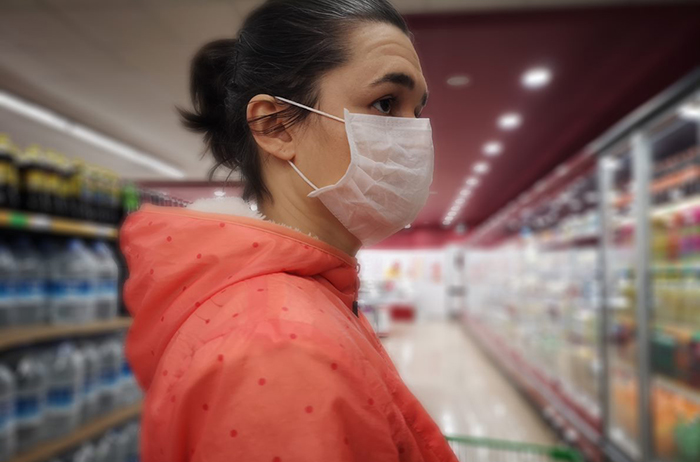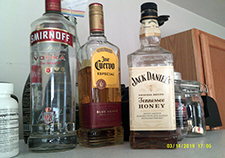Office of Research & Development |
 |


Studies show that food insecurity in Veterans is highly intertwined with physical and mental health, military culture, and lack of basic resources. (Photo for illustrative purposes only: @Getty Images/oonal)
February 14, 2022
By Erica Sprey
VA Research Communications
"People who are food insecure are making choices on how to spend their last $20 or $50. Usually food is the flexible component, so they apply it to rent."
Photo-elicitation is a research method that combines detailed interviews with photographs taken by study participants. Researchers use it to gain a better understanding of complex topics. Often, the act of taking photographs—in response to questions from the researcher—can summon emotional responses in study participants. It can also help both participants and researchers gain insight into participants’ behaviors.
Dr. Nipa Kamdar is a researcher at the VA Center for Innovations in Quality, Effectiveness and Safety (iQUeSt) in Houston. Her focus is food insecurity in Veterans. In October 2021, Kamdar published a commentary, in Public Health Nursing, on her use of photo-elicitation to study food insecurity in low-income, post 9/11 Veterans.
![[This is a picture of what was] in my fridge when I first started the project. You see [there's] hardly anything in there? And see how small the fridge is?](/images/research-currents/feb22/mini-fridge-sm.jpg)
"[This is a picture of what was] in my fridge when I first started the project. You see [there's] hardly anything in there? And see how small the fridge is?" (Photo taken by Veteran study participant.)
The article discussed the results of an earlier study by Kamdar and colleagues that used photo-elicitation to better understand food insecurity in a group of post 9/11 Veterans with children. The researchers found that food insecurity in Veterans is highly intertwined with physical and mental health, military culture, and lack of basic resources like housing or transportation.
Kamdar reached out to several community organizations and Veteran Service Organizations (VSOs) to recruit low-income Veterans with children who were students in and around Houston and College Station, Texas. These regions were targeted because they had a higher rate of food insecurity (16%-20%) than the national average (10.5%). The final sample included 21 Veterans.
She initially met with each participant at their college, or a local coffee shop, to explain the photo-elicitation process and to give them a camera. She met with the Veterans 10 days later to collect their photos and conduct detailed interviews.
![Those are my medications. But the side effects [make it hard to] keep a job and financial stability—whether it's dizziness, or sleeping too much, or not thinking right. I feel like they affect my ability to perform. The pain from my injuries also influences my performance at work.](/images/research-currents/feb22/medicine-bottles-sm.jpg)
"Those are my medications. But the side effects [make it hard to] keep a job and financial stability—whether it's dizziness, or sleeping too much, or not thinking right. I feel like they affect my ability to perform. The pain from my injuries also influences my performance at work." (Photo taken by Veteran study participant.)
Kamdar asked the Veterans to take photos illustrating how they got food to their tables, what they ate, and how they felt about the process. Kamdar says that photos can often portray a hidden story. Rather than ordinary photographs showing a grocery store or cooking, Veterans might take a photo of a curbside pick-up because they do not want to go into an enclosed building filled with strangers. Or they might capture images of the pasta that they prepare four-to-five nights a week, because it is cheap and filling.
"Some Veterans told me the process of going to the grocery store, buying food, making a meal, and putting it on the table was an automatic thing—they never thought about the decisions they were making. But when I gave them the camera and asked them to document the process, it made them slow down and think," says Kamdar. "One of them said, 'I never knew how much my anxiety dictated how I went to the store, or when I went to the store.'"
Kamdar notes that photo-elicitation can also be an effective tool for advocacy, helping to create empathy for issues affecting vulnerable populations.
![We have the G.I. Bill, the Hazelwood Act, and the 'Voca Rehab' [Vocational Rehabilitation and Employment], but right now, I'm just using the G.I. Bill. It's the money from the G.I. Bill that helps us pay bills and stuff.](/images/research-currents/feb22/GI-bill-sm.jpg)
"We have the G.I. Bill, the Hazelwood Act, and the 'Voca Rehab' [Vocational Rehabilitation and Employment], but right now, I'm just using the G.I. Bill. It's the money from the G.I. Bill that helps us pay bills and stuff." (Photo taken by Veteran study participant.)
Food insecurity is defined as a limited ability to access food, largely due to financial considerations. In the U.S. population, about 10% of adults experience food insecurity, according to a 2020 report by the U.S. Department of Agriculture.
Veterans have about the same rate of food insecurity as the general population, but differ in their level of food insecurity, according to a 2021 study that looked at working-age Veterans with children. Veterans often experience a greater severity of food insecurity, Kamdar notes. "That severe level means they are cutting down on what they eat, or they are skipping meals."
Food insecurity rarely exists on its own. Kamdar analyzed data collected from participating VSOs and found that food insecurity was a complex problem that often occurred in tandem with housing and financial insecurities.
"'You are never just food insecure,' one Veteran told me," she notes. "People who are food insecure are making choices on how to spend their last $20 or $50. Do they spend it on rent? Or do they spend it on food? Usually food is the flexible component, so they apply it to rent."
Studies have also found an association between food insecurity and mental health issues like depression and suicidal thoughts. In a 2021 study, Kamdar and colleagues examined data from 2,630 Veterans who participated in the National Health and Nutrition Examination Survey between 2007-2016. They found that Veterans who had low or very low food security had significantly higher depression scores and were more likely to report thoughts of suicide compared to Veterans who were food secure.
Mental health issues can also affect how Veterans care for their children. One father in Kamdar's photo-elicitation study told her he had "fend-for-yourself nights" in his household. They had food in the refrigerator, but on those days, neither he nor his wife were able to prepare food for the children because of a poor mental state. In that instance, says Kamdar, children are likely to choose easily prepared foods, like ramen noodles or toaster pastries, which typically have poor nutritional value.

"I feel that alcohol helps me at times, but I know it's bad for my health. It's one of the things that I want to change one day. I've been going to therapy to stop drinking, but I know it's one of my weaknesses. That's why I took a picture of it." (Photo taken by Veteran study participant.)
In November 2021, Kamdar testified as a private citizen before the U.S. House Committee on Agriculture, Subcommittee on Nutrition, Oversight, and Department Operations. The subcommittee heard testimony on the problem of hunger among Veterans and servicemembers.
Kamdar says she wants policy makers to understand that food insecurity doesn't exist in a silo.
Referring a Veteran to a food pantry or directing them to apply for food stamps can help with immediate needs, but it should not be viewed as a complete solution. She says a broader approach is needed that takes into account an individual's mental health, physical well-being, and other factors like housing, financial stability, and access to transportation.
"If I can show someone a picture taken by a Veteran of food on their table, or a grocery cart, that's more striking than a graph showing the prevalence of food insecurity," says Kamdar. "Pictures are a more effective tool to get the attention of policy makers and show them that food insecurity is a real issue, affecting real people."
VA Research Currents archives || Sign up for VA Research updates